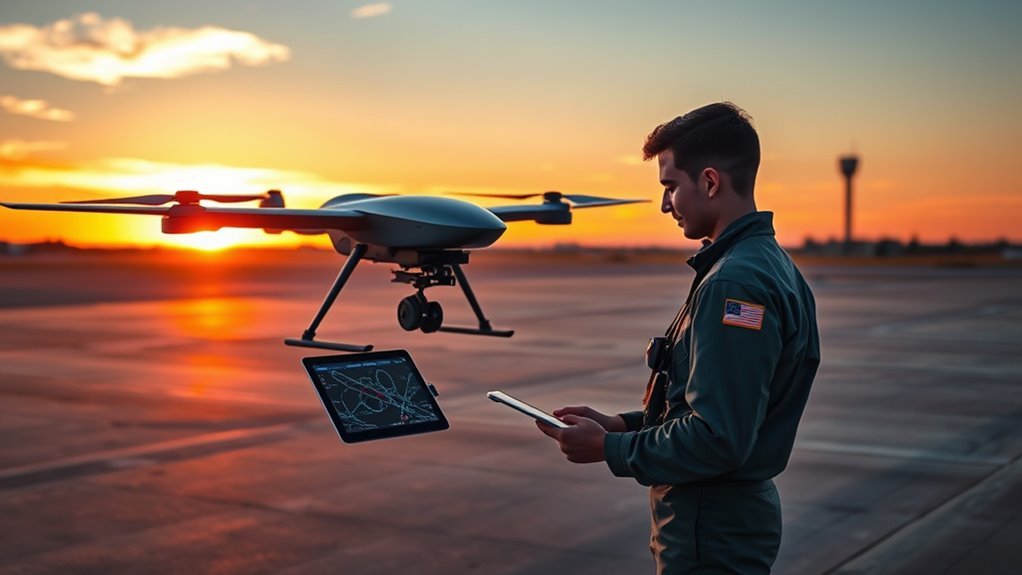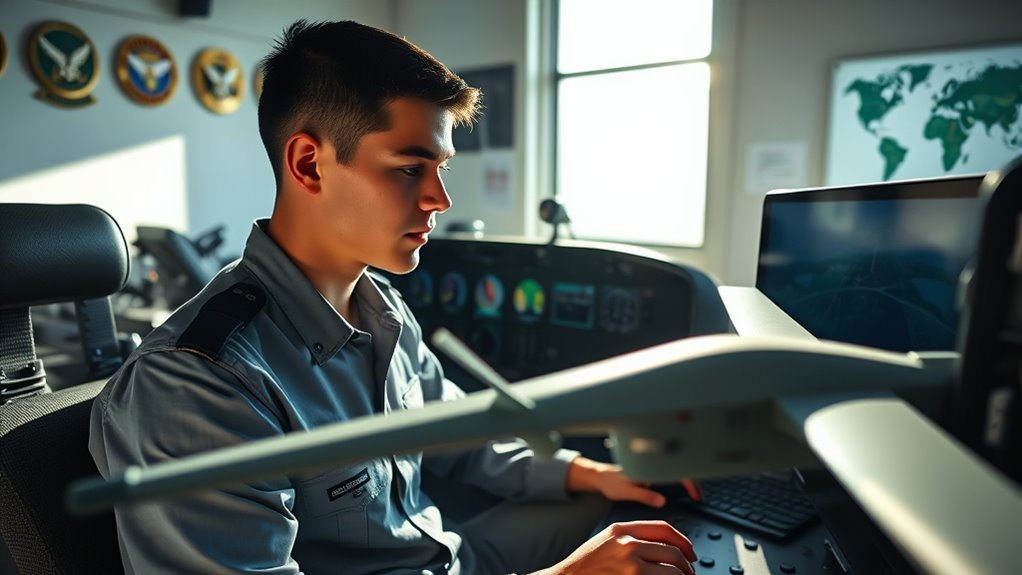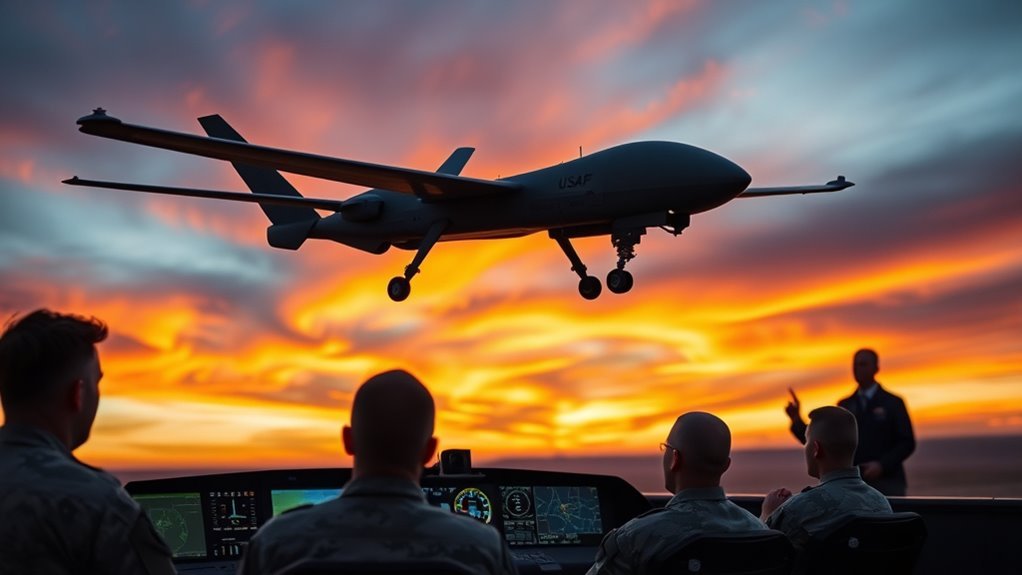To become a USAF drone pilot, start by ensuring you meet the basic qualifications, including age and citizenship. Pursue a relevant bachelor’s degree and enhance your skills through simulations and technical courses. Next, enlist in the military and complete the Officer Training School (OTS). Gain flight experience and certifications, including the FAA Remote Pilot Certificate. Focus on continuous professional development to advance your career in drone operations. Discover the evolving landscape of UAV technology as you progress.
Understanding the Role of a USAF Drone Pilot

As you explore the role of a USAF drone pilot, you’ll find that it encompasses much more than simply operating unmanned aerial vehicles (UAVs). Your primary responsibility involves executing mission objectives with precision and efficiency. You’ll analyze intelligence data to develop operational strategies that enhance situational awareness and inform tactical decisions. Collaboration with ground forces and other aerial assets guarantees that you’re aligned with the broader objectives of military operations. You’ll also be tasked with monitoring UAV systems, troubleshooting issues, and adapting to evolving scenarios in real-time. This multifaceted role demands not only technical expertise but also critical thinking skills, enabling you to contribute considerably to the Air Force’s mission and the pursuit of freedom in diverse environments.
Basic Qualifications and Requirements

To become a USAF drone pilot, you’ll need to meet specific age and citizenship criteria, along with educational and experiential benchmarks. Health and fitness standards are also vital to guarantee operational readiness. Understanding these basic qualifications is fundamental for your application process.
Age and Citizenship Criteria
Becoming a USAF drone pilot involves meeting specific age and citizenship criteria that guarantee candidates are prepared for the responsibilities of the role. First, you must be a U.S. citizen; this is a fundamental requirement due to the sensitive nature of military operations. Additionally, age limitations are in place: you should be between 18 and 34 years old at the time of your application. This age range guarantees you’re physically and mentally equipped for the demands of piloting drones. Fulfilling these citizenship requirements and age limitations is vital for safeguarding national security and operational effectiveness. If you meet these criteria, you’re one step closer to pursuing a rewarding career in the United States Air Force as a drone pilot.
Education and Experience Needed
While you may meet the age and citizenship criteria, the path to becoming a USAF drone pilot also hinges on specific educational and experiential qualifications. You’ll need a bachelor’s degree in a relevant field, such as aerospace engineering, computer science, or information technology. This education equips you with the technical skills necessary to operate complex drone systems effectively. Additionally, experience in piloting or operating unmanned aerial systems can enhance your application. Participation in internships or training programs related to aviation technology can also be beneficial. Ultimately, the combination of your educational background and hands-on experience will help you stand out, ensuring you’re well-prepared for the challenges of drone piloting in the U.S. Air Force.
Health and Fitness Standards
Since drone pilots in the U.S. Air Force must meet strict health and fitness standards, you’ll need to prioritize your physical conditioning. You’ll undergo multiple fitness assessments to guarantee you’re in peak health. These assessments typically include aerobic tests, strength evaluations, and flexibility measurements. Maintaining a solid fitness level isn’t just about passing a test; it’s vital for operational readiness and overall well-being. A strong body supports mental acuity, significant for effective decision-making in high-stakes environments. To excel as a drone pilot, commit to a consistent fitness regimen that enhances endurance, strength, and agility. Remember, your ability to perform in the cockpit hinges on your physical state, so embrace this responsibility as part of your journey to freedom in the skies.
Educational Pathways to Becoming a Drone Pilot

To commence a career as a USAF drone pilot, you’ll need to follow a structured educational pathway that combines technical knowledge with practical skills. Here are key steps to contemplate:
- Enroll in educational institutions offering aviation programs that focus on unmanned aerial systems.
- Pursue online courses for flexible learning, covering essential topics like systems operations and data analysis.
- Attend military academies to gain leadership skills and a thorough understanding of military operations.
- Obtain technical certifications through recognized entities, and engage in pilot simulations to hone your flying and decision-making skills.
Military Enlistment Process
Steering through the military enlistment process is crucial for aspiring USAF drone pilots, as it sets the foundation for your career. Start by researching the military recruitment process, which includes meeting eligibility requirements, such as age, citizenship, and health standards. Next, you’ll take the Armed Services Vocational Aptitude Battery (ASVAB) test, which assesses your skills and determines suitable roles. Upon passing, you’ll engage with a recruiter who will guide you through paperwork and explain enlistment benefits, which can include education assistance and healthcare. Once you complete the necessary steps, including background checks and physical examinations, you’ll be ready to enlist. This process is essential for ensuring you’re prepared for the challenges ahead and for achieving your goal of becoming a drone pilot.
Officer Training School (OTS) Overview
Officer Training School (OTS) is designed to develop your leadership skills and tactical acumen. The program structure includes rigorous academic coursework, physical training, and practical exercises. Key training components focus on military ethics, decision-making, and effective communication, all essential for your role as a USAF officer.
OTS Program Structure
While pursuing a career as a USAF drone pilot, understanding the structure of the Officer Training School (OTS) is vital. The OTS program offers several benefits but also presents unique challenges. Here’s a breakdown of the program structure:
- Duration: OTS typically lasts 12 weeks, focusing on leadership and military skills.
- Physical Conditioning: You’ll undergo rigorous physical training to guarantee readiness.
- Academic Rigor: Expect intense coursework that covers military protocols and decision-making.
- Field Training: Hands-on experiences in real-world scenarios are essential for practical learning.
Navigating these components effectively can enhance your leadership capabilities and resilience, empowering you to thrive in the demanding role of a drone pilot.
Key Training Components
Understanding the key training components of the Officer Training School (OTS) is essential for aspiring drone pilots, as these elements shape the foundation of your military career. OTS provides rigorous instruction in leadership, military protocols, and operational planning. You’ll gain essential pilot skills, including decision-making under pressure and effective communication, which are imperative in controlling advanced drone technology. Physical fitness and ethical decision-making are also emphasized, ensuring you’re prepared for the demands of the role. In addition, hands-on experience with drone systems during flight training enhances your technical proficiency. Mastering these components not only equips you for success in the USAF but also cultivates the independence and critical thinking necessary for future challenges in the ever-evolving field of aerial operations.
Specialized Drone Pilot Training
As you begin the journey to become a specialized drone pilot in the USAF, you’ll undergo rigorous training that focuses on both technical skills and tactical awareness. This training emphasizes advanced flight techniques and stays current with drone technology advancements. You’ll engage in various critical areas, including:
- Systems Operation: Mastering the drone’s hardware and software components.
- Flight Maneuvers: Practicing advanced flight techniques in various scenarios.
- Tactical Integration: Understanding how to effectively utilize drones in combat situations.
- Mission Planning: Developing the ability to create and execute complex flight missions.
This specialized training not only enhances your piloting skills but also prepares you for real-world applications, ensuring you can operate with confidence and precision in diverse environments.
Gaining Experience Through Flight Hours
After completing specialized training, gaining flight hours becomes a significant aspect of your development as a USAF drone pilot. You’ll engage in flight simulation exercises that mirror real-world applications, enhancing your skills in mission planning and aerial tactics. Hands-on training is essential; it allows you to familiarize yourself with the equipment and understand its capabilities in various operational scenarios. As you accumulate flight hours, you’ll also refine your team coordination skills, critical for successful missions. Each hour spent in the air strengthens your decision-making and operational efficiency. Embrace the challenges of flight hours, as they’re important for your growth, ensuring you’re prepared for the complexities of modern aerial warfare and the freedom it entails.
Certification and Licensing
While you may have honed your skills through extensive flight hours, obtaining the necessary certification and licensing is essential to your role as a USAF drone pilot. The certification process involves several critical steps, ensuring you meet all licensing requirements:
- Complete Initial Training: Enroll in a USAF-approved training program focused on UAV operations.
- Pass Written Exams: Demonstrate your knowledge of aviation principles and UAV systems through standardized tests.
- Obtain Flight Certification: Successfully execute flight maneuvers under the supervision of certified instructors.
- Receive FAA Remote Pilot Certificate: If applicable, secure this certificate to legally operate drones commercially.
Meeting these requirements not only validates your skills but also empowers you to contribute effectively to mission objectives.
Advancing Your Career as a Drone Pilot
To advance your career as a drone pilot in the USAF, you must actively seek opportunities for professional development and specialization. Embrace training programs that focus on advanced drone technology, as these skills will set you apart. Consider earning additional certifications in areas like intelligence gathering or combat operations. Networking with experienced pilots and attending industry conferences can also provide valuable insights and connections for career advancement. Stay updated on emerging drone technologies, as this knowledge is essential in a rapidly evolving field. Pursuing leadership roles and participating in cross-training initiatives will further enhance your skill set, making you a more versatile asset to your unit. Additionally, consider engaging in proactive vulnerability identification to enhance your understanding of the security challenges facing drone operations. Understanding the importance of advanced autonomy in modern drone systems will also prepare you for the future landscape of aerial technology. Take charge of your professional journey and release your potential as a drone pilot.
The Future of Drone Operations in the USAF
As advancements in technology continue to reshape military operations, the future of drone operations in the USAF promises to be both dynamic and transformative. You’ll witness a shift driven by future technologies that enhance capabilities while also raising ethical implications. Here are key areas to watch:
- AI Integration: Autonomous decision-making will improve mission efficiency, while AI-driven solutions will further optimize operational effectiveness.
- Enhanced Surveillance: Next-gen sensors will provide unprecedented intelligence.
- Cybersecurity Measures: Protecting data integrity will be paramount.
- Regulatory Frameworks: New policies will guide ethical drone use and accountability.
In this context, understanding NDAA compliance will be essential for safeguarding sensitive data and maintaining operational integrity. As these developments unfold, drone pilots like you will play a crucial role in ensuring that these advancements align with the values of freedom and responsibility in military operations. Prepare to adapt and thrive in this evolving landscape.
Frequently Asked Questions
What Are the Physical Fitness Requirements for Drone Pilots?
To qualify as a drone pilot, you’ll need to pass fitness assessments that align with military health standards. Maintaining physical fitness guarantees you can handle the demands of the role effectively and responsibly.
Can Civilians Become Drone Pilots in the USAF?
Ever wonder if you can serve your country as a drone pilot? While civilians can’t directly join the USAF, certain civilian qualifications and pilot training can lead to opportunities within defense contracting or related fields.
How Are Drone Pilots Evaluated and Promoted?
Drone pilots are evaluated based on performance metrics, technical proficiency, and leadership abilities. The promotion process considers these evaluation criteria, alongside mission success and contribution to team dynamics, ensuring only the most capable advance.
What Is the Average Salary of a USAF Drone Pilot?
Think of a drone pilot as a skilled conductor, orchestrating missions. The average salary ranges from $70,000 to $100,000, showing promising salary comparison and job outlook, reflecting the importance of these roles in modern warfare.
What Benefits Do USAF Drone Pilots Receive?
USAF drone pilots enjoy numerous benefits, including career advancement potential and extensive training opportunities. These perks not only enhance your skills but also pave the way for future roles within the military and beyond.

